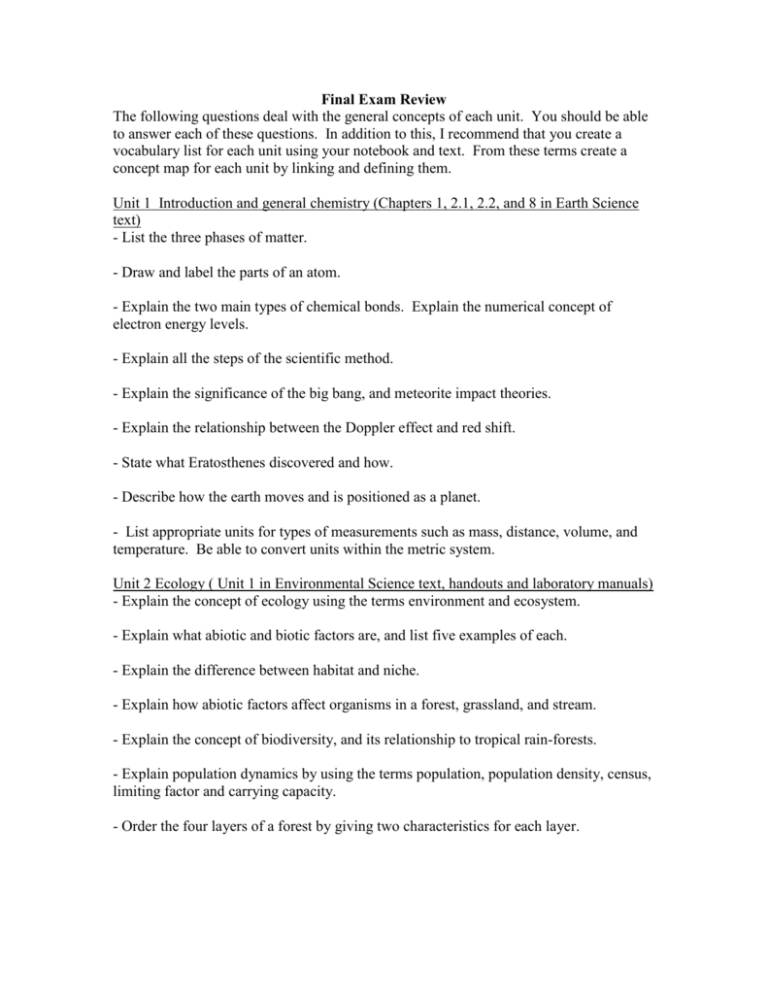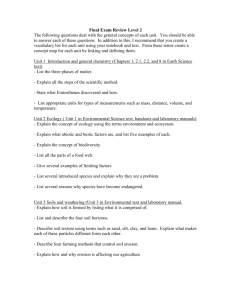Final exam review packet L-1
advertisement

Final Exam Review The following questions deal with the general concepts of each unit. You should be able to answer each of these questions. In addition to this, I recommend that you create a vocabulary list for each unit using your notebook and text. From these terms create a concept map for each unit by linking and defining them. Unit 1 Introduction and general chemistry (Chapters 1, 2.1, 2.2, and 8 in Earth Science text) - List the three phases of matter. - Draw and label the parts of an atom. - Explain the two main types of chemical bonds. Explain the numerical concept of electron energy levels. - Explain all the steps of the scientific method. - Explain the significance of the big bang, and meteorite impact theories. - Explain the relationship between the Doppler effect and red shift. - State what Eratosthenes discovered and how. - Describe how the earth moves and is positioned as a planet. - List appropriate units for types of measurements such as mass, distance, volume, and temperature. Be able to convert units within the metric system. Unit 2 Ecology ( Unit 1 in Environmental Science text, handouts and laboratory manuals) - Explain the concept of ecology using the terms environment and ecosystem. - Explain what abiotic and biotic factors are, and list five examples of each. - Explain the difference between habitat and niche. - Explain how abiotic factors affect organisms in a forest, grassland, and stream. - Explain the concept of biodiversity, and its relationship to tropical rain-forests. - Explain population dynamics by using the terms population, population density, census, limiting factor and carrying capacity. - Order the four layers of a forest by giving two characteristics for each layer. - List 4 dominant tree, shrub, and animal species in our area. - List all the parts of a food web. - Explain the energy pyramid and how energy moves through an ecosystem. - Give several examples of limiting factors - List several introduced species and explain why they are a problem. - List several reasons why species have become endangered. - List pros and cons to timber harvesting. - Explain two types of timber harvesting techniques. - Be able to diagram the nitrogen, and carbon-oxygen cycles. Unit 3 Soils and weathering (Unit 3 in Environmental text and laboratory manual. - Explain how soil is formed by listing what it is comprised of. - List and describe the four soil horizons. - Describe soil texture using terms such as sand, silt, clay, and loam. Explain what makes each of these particles different form each other. - Describe four farming methods that control soil erosion. - Explain what a macronutrient is and name the three most important ones for plants. - Explain the difference between mechanical and chemical weathering by giving examples of each type. - Explain four things that affect the rate of weathering. - Explain how and why erosion is affecting our agriculture - Explain the historical significance of pesticides. - Explain the side effects of DDT and the concept of bioaccumulation. - Explain the methods of integrated pest management. Unit 4 Water (Unit 4 in Environmental Science Text) - Describe five water chemical parameters, and what different values for each indicate. - Explain what a watershed is as well as the difference between cold and warm water environments. - Create a diagram of the water cycle defining each process. - List the three characteristics of wetlands. - List at least five values of wetlands. - List the various forms of oater pollution and classify them as either point non-point. Unit 5 Geology - rocks and mineral (Chapters 9 and 10) - Explain the four basic chemical structures of minerals, and name the two main types of minerals. - Name four characteristics of minerals and explain five mineral properties. - Diagram the rock cycle by linking each stage by its appropriate process. - Describe the two ways igneous rocks form, and name five common igneous rocks. - Name the three groups of igneous rock, and describe how they are grouped. - List six different igneous rock structures as intrusive or extrusive. - Explain the three different types of sedimentary rock groups, and give an example of each. - Describe six sedimentary features by how they form. - Describe the two ways metamorphic rocks form. - Explain how the two groups of metamorphic rocks differ, and name two examples of each group. Unit 6 Energy and natural resources (Unit 5 in Environmental text, laboratory manual and chapter 11 in earth Science text) - State the two laws of energy. - Give an example of potential and kinetic energy, and relate the definition of energy to work and force. - List three examples of renewable and non-renewable resources. - Define the process of how fossil fuels formed. Describe the four stages of coal formation. - Describe three ways oil, natural gas, and coal are both similar and different as energy sources. - List and briefly describe all the alternative energies used in this country by naming a pro and con for each one. - Explain the two different forms of solar heating as well as various other solar energy technologies. Unit 7 Meteorology (Chapters 23,24, 25,and 26) - Explain how the terms dew point, relative humidity, specific humidify, and frost are related to each other. - Name the measuring device and units for temperature, pressure, humidity, and wind speed. - Name all the global winds, and relate them to high and low pressure. - Describe the Coriolis effect on global winds and high and low pressure systems. - Explain how convection and conduction differ, and how convection is responsible for both local and global winds. - Name the four layers of the atmosphere and give a characteristic of each. - List the gases of the atmosphere in their order of abundance. - Name and describe three factors that affect heat absorption and release. - Compare scattering, reflection, and the absorption of energy. Relate them to the greenhouse effect. - Explain how the electromagnetic spectrum changes from one end to the other. Rank the different forms of energy due to their wavelength. - In order of altitude, name seven cloud types and what they indicate. - Explain the greenhouse effect and how it may contribute to global climate change. Explain the problem with the ozone layer and what effects of this problem.. - Name five different forms of precipitation and explain how they differ. - State the equation for air pressure. - Compare the four types of fronts to each other and explain what each one indicates. - Name and describe the four main types of air masses. List the seven air masses in North America. - Transform weather data into map symbols, and explain the concept of isobars. - Describe three ways high and low pressure systems differ. - Explain how lightning occurs, using four steps. - Compare characteristics of thunderstorms, tornadoes, and hurricanes. Unit 8 Geological history (Chapters 4.1, 4.2, 17, 18, and 19) - Explain the differences between relative and absolute dating. - Name the three early theories of crustal movement, and how they formulated the plate tectonic theory. - List three important steps from Pangaea to the present. - Name the three types of plate movements, and give an example of what they form. - List the four eras of geological time and know the general order of major occurrences throughout the earth’s history.











